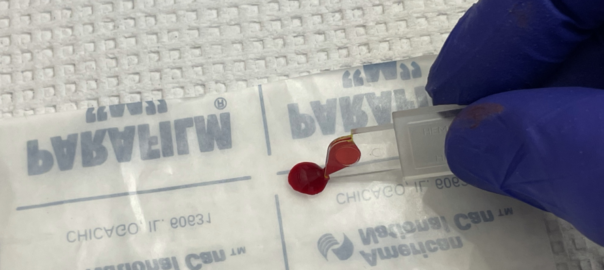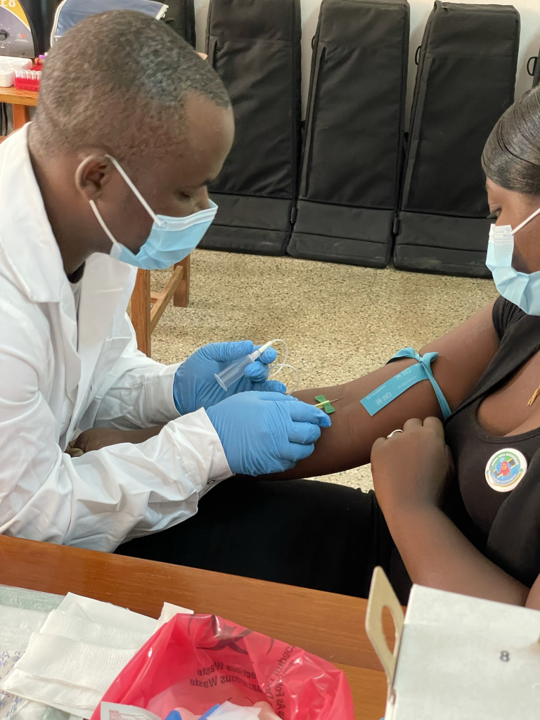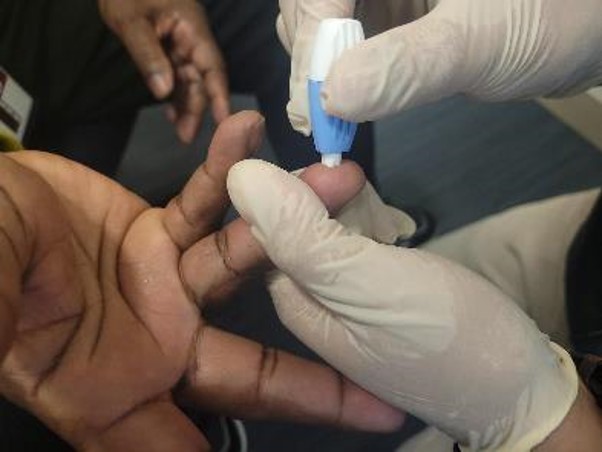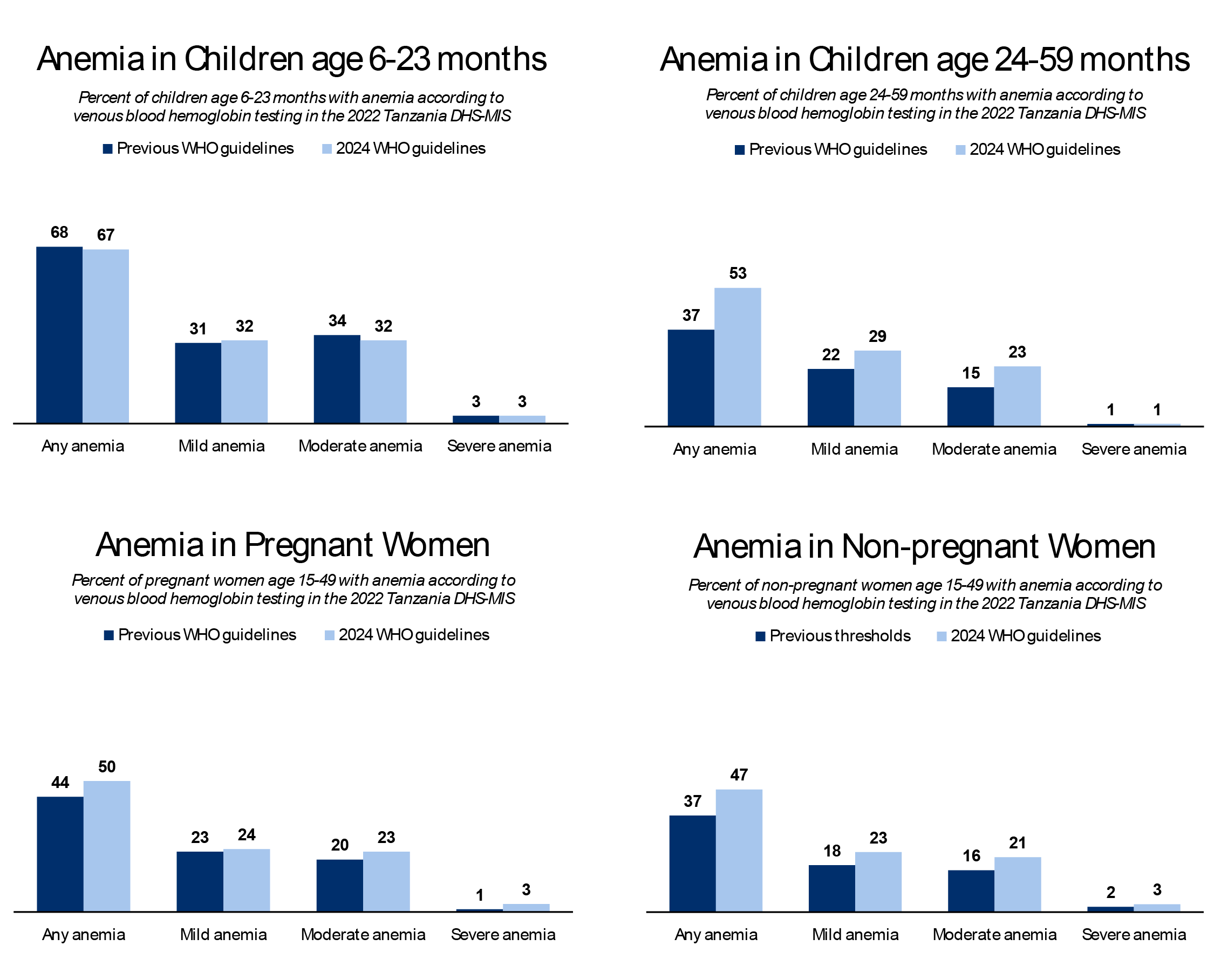Hemoglobin Collection at The DHS Program: Impact of Updated WHO Guidelines on DHS Program Anemia Data

Anemia occurs when there are not enough healthy red blood cells to carry oxygen to tissues in the body. Anemia is estimated to affect more than 250 million children under age 5 and more than half a billion women of reproductive age worldwide. When severe, anemia can lead to impaired cognitive and motor development in children and adverse birth outcomes, even death, for pregnant women.
Since 1995, The DHS program has been a leading provider of anemia data globally. The DHS Program follows World Health Organization (WHO) guidance for the collection of hemoglobin, a protein responsible for transporting oxygen in the blood and the biomarker used to assess prevalence of anemia. The WHO guidance includes recommendations on blood source, equipment, hemoglobin concentration cut-off points to define anemia (based on age, sex, and pregnancy status), and hemoglobin concentration adjustments for cigarette smoking and elevation.
In March 2024, WHO released new guidelines on hemoglobin cutoffs to define anemia. The new guidelines introduce three key updates:
- Changes to how hemoglobin concentration should be measured.
- New cut-offs for anemia among young children and pregnant women.
- Revised hemoglobin concentration adjustments for cigarette smoking and elevation.
Read about each of these updates below:
1. Hemoglobin Concentration Measurement

Hemoglobin is assessed in a whole blood sample using either venous or capillary blood. Venous blood samples are collected from a vein, usually from the inside of the elbow or the back of the hand. Capillary blood samples are collected by pricking the skin of the finger or heel. The DHS Program routinely assesses hemoglobin concentration from single-drop capillary blood samples using the HemoCue testing system. However, recent evidence suggests that hemoglobin concentration varies based on the blood source, whether capillary or venous. The DHS Program conducted a method-comparison study on hemoglobin measurement in venous blood compared with pooled and single-drop capillary blood which found differences in mean hemoglobin concentration of venous and capillary blood samples measured using the HemoCue 201+ testing system and an automated hematology analyzer. Other studies1 have reported similar findings, emphasizing the impact of blood source on anemia prevalence estimates. The unpredictable variability in single-drop capillary hemoglobin measurements can lead to inaccurate anemia prevalence estimates and trends.


The latest WHO guidelines recommend using venous blood samples and automated hematology analyzers within laboratory settings to estimate anemia prevalence. However, in field conditions where lab analysis is impractical, approved point-of-care testing devices—such as the HemoCue testing system—can be a viable alternative.
2. Cut-offs to Define Anemia

Hemoglobin concentration cut-offs are used to define anemia and its severity. According to the latest WHO guidelines, children age 6-23 months now have a lower threshold for anemia than before. Additionally, trimester specific cut-offs are now recommended for pregnant women. Notably, pregnant women in their second trimester now have a lower threshold for anemia than the previous threshold for all pregnant women. These new thresholds were determined using a statistical definition derived from an analysis of hemoglobin measured in healthy populations.
| Anemia Status among children | Previous WHO guidelines | 2024 WHO guidelines | |
|---|---|---|---|
| Hemoglobin level in grams/deciliter among children age 6-59 months | Hemoglobin level in grams/deciliter among children age 6-23 months | Hemoglobin level in grams/deciliter among children age 24-59 months | |
| Any anemia | <11.0 | <10.5 | <11.0 |
| Mild anemia | 10.0-10.9 | 9.5-10.4 | 10.0-10.9 |
| Moderate anemia | 7.0-9.9 | 7.0-9.4 | 7.0-9.9 |
| Severe anemia | <7.0 | <7.0 | <7.0 |
| Anemia Status among women | Previous WHO guidelines | 2024 WHO guidelines | ||||
|---|---|---|---|---|---|---|
| Hemoglobin level in grams/deciliter among non-pregnant women | Hemoglobin level in grams/deciliter among pregnant women | Hemoglobin level in grams/deciliter among non-pregnant women | Hemoglobin level in grams/deciliter among pregnant women in the first trimester | Hemoglobin level in grams/deciliter among pregnant women in the second trimester | Hemoglobin level in grams/deciliter among pregnant women in the third trimester | |
| Any anemia | <12.0 | <11.0 | <12.0 | <11.0 | <10.5 | <11.0 |
| Mild anemia | 11.0-11.9 | 10.0-10.9 | 11.0-11.9 | 10.0-10.9 | 9.5-10.4 | 10.0-10.9 |
| Moderate anemia | 8.0-10.9 | 7.0-9.9 | 8.0-10.9 | 7.0-9.9 | 7.0-9.4 | 7.0-9.9 |
| Severe anemia | <8.0 | <7.0 | <8.0 | <7.0 | <7.0 | <7.0 |
3. Elevation and Cigarette Smoking Adjustments

Before applying cut-offs to define anemia, hemoglobin concentration is adjusted for respondents based on their elevation above sea level and among those adults who smoke cigarettes. Here’s why:
| Elevation | Smoking |
|---|---|
| o As elevation increases, atmospheric oxygen availability declines. | o Smoking cigarettes introduces carbon monoxide to the body, reducing its oxygen-carrying capacity. |
| o To compensate, the body increases hemoglobin concentration, ensuring adequate oxygen supply. | o In response, the body elevates hemoglobin concentration to counteract oxygen deprivation. |
| o Populations residing at high elevations above sea level may exhibit higher hemoglobin concentration than those at lower elevations, so hemoglobin concentration is adjusted for respondents based on the elevation where they live. | o Smokers may therefore have elevated hemoglobin concentration as compared to non-smokers, so their hemoglobin concentration is adjusted. |
Failure to adjust hemoglobin concentration for elevation and smoking before applying the cut-offs may lead to an underestimation of anemia prevalence.
The latest WHO guidelines introduce revised formulas for elevation and smoking adjustments. Adjustments now begin at an elevation of 500 meters, whereas before they began at 1000m. For smoking, the formula changed from packs per day to cigarettes per day.

Anemia estimates for children and women in the 2022 Tanzania DHS-MIS (micronutrient sample) vary depending on whether previous guidelines or 2024 WHO guidelines, including new cut-offs and revised elevation and smoking adjustments, are used. For children age 6-23 months, anemia estimates are slightly lower due to the lower threshold for this age group. However, for children age 24-59 months and both pregnant and non-pregnant women, the anemia estimates are higher. This increase is primarily due to the updated adjustments for elevation and smoking (the lower threshold in the second trimester for pregnant women has only a negligible effect on the overall estimate).
What do these changes mean for The DHS Program?
The DHS Program has begun to incorporate the new WHO guidelines on hemoglobin collection into surveys currently collecting data. Ultimately, the updated hemoglobin collection guidelines will affect past and future anemia data in DHS surveys. The DHS Program has begun making the following key changes:
- The DHS Program will no longer use single drop capillary blood for hemoglobin measurement but will use venous blood instead.
- The HemoCue 201+ testing system will continue to be used in surveys as it makes it possible to give results to respondents and make referrals for those with severe anemia to go to a local health facility for treatment.
- Anemia estimates and trends derived from single drop capillary blood should be interpreted with caution because of the variability of single drop capillary blood. Anemia estimates based on capillary and venous blood are not comparable and should not be used interchangeably. Read about capillary and venous blood collected in Rwanda and Tanzania.
- The new formulas for the elevation and smoking adjustments and the updated hemoglobin concentration cut-offs will be used to report anemia in survey Final Reports from now on. Because of the new adjustments and cut-offs, anemia estimates in forthcoming and future surveys cannot be compared with those from previous surveys.
The new WHO guidelines highlight key areas of future research. For example, one area to explore is whether correction factors can be applied to anemia data collected via capillary blood to make it comparable to venous blood estimates. These and other questions are currently being studied, and The DHS Program will adapt as new findings emerge. Look out for future blog posts in the hemoglobin collection series!
- Hruschka, D. J., et al. 2020. Comparing Hemoglobin Distributions between Population-based Surveys Matched by Country and Time. BMC Public Health 20(422) (March 30) doi:10.1186/s12889-020-08537-4.
Stevens, G. A., et al. 2022. Associations between Type of Blood Collection, Analytical Approach, Mean Haemoglobin and Anaemia Prevalence in Population-based Surveys: A Systematic Review and Meta-Analysis. Journal of Global Health 12(04088) (November 23). doi:10.7189/jogh.12.04088.
Neufeld, L. M., et al. 2019. Hemoglobin Concentration and Anemia Diagnosis in Venous and Capillary Blood: Biological Basis and Policy Implications. Annals of the New York Academy of Sciences 1450: 172–189. doi:10.1111/nyas.14139.
Hackl, L. S., Karakochuk, C. D., Mazariegos, D. I., Jeremiah, K., Obeid, O., Ravi, N., Ayana, D. A., Varela, V., Alayón, S., Dary, O., & Moorthy, D. (2024). Assessing Accuracy and Precision of Hemoglobin Determination in Venous, Capillary Pool, and Single-Drop Capillary Blood Specimens Using three Different HemoCue® Hb Models: The Multicountry Hemoglobin Measurement (HEME) Study. The Journal of nutrition, 154(7), 2326–2334. https://doi.org/10.1016/j.tjnut.2024.03.019 ↩︎
Feature image ©ICF

